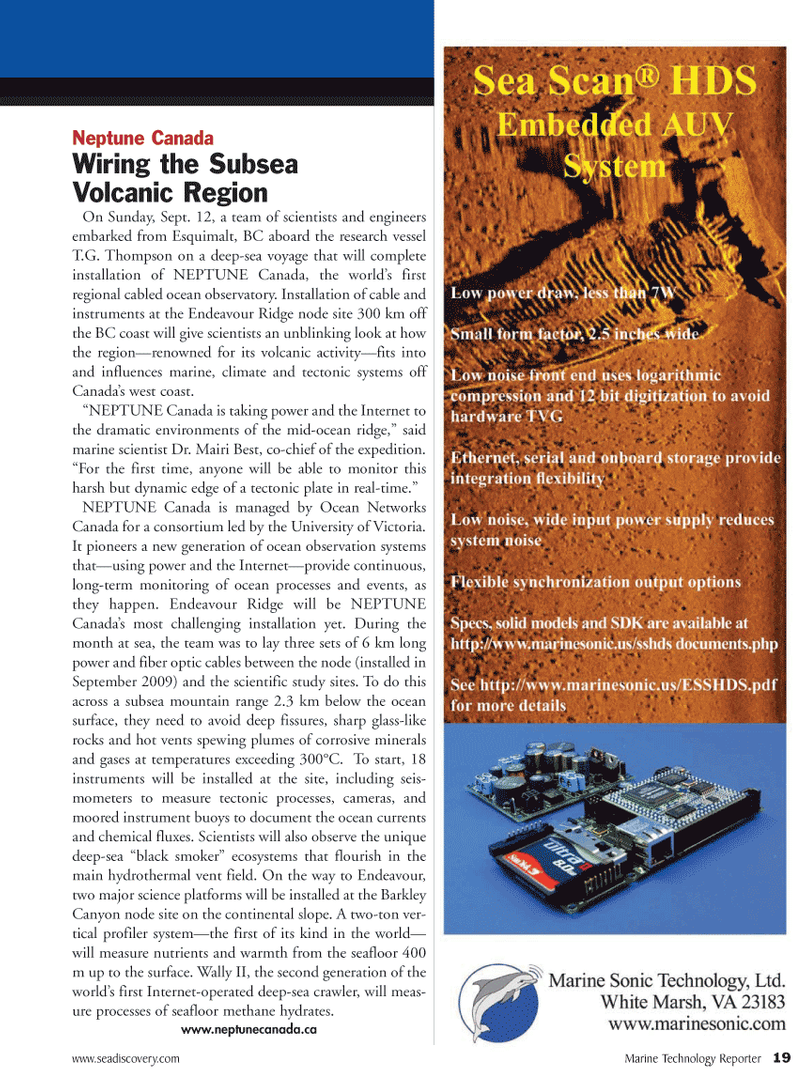
Page 19: of Marine Technology Magazine (October 2010)
Ocean Engineering & Design
Read this page in Pdf, Flash or Html5 edition of October 2010 Marine Technology Magazine
www.seadiscovery.com Marine Technology Reporter 19
Neptune Canada
Wiring the Subsea
Volcanic Region
On Sunday, Sept. 12, a team of scientists and engineers embarked from Esquimalt, BC aboard the research vessel
T.G. Thompson on a deep-sea voyage that will complete installation of NEPTUNE Canada, the world’s first regional cabled ocean observatory. Installation of cable and instruments at the Endeavour Ridge node site 300 km off the BC coast will give scientists an unblinking look at how the region—renowned for its volcanic activity—fits into and influences marine, climate and tectonic systems off
Canada’s west coast. “NEPTUNE Canada is taking power and the Internet to the dramatic environments of the mid-ocean ridge,” said marine scientist Dr. Mairi Best, co-chief of the expedition. “For the first time, anyone will be able to monitor this harsh but dynamic edge of a tectonic plate in real-time.”
NEPTUNE Canada is managed by Ocean Networks
Canada for a consortium led by the University of Victoria.
It pioneers a new generation of ocean observation systems that—using power and the Internet—provide continuous, long-term monitoring of ocean processes and events, as they happen. Endeavour Ridge will be NEPTUNE
Canada’s most challenging installation yet. During the month at sea, the team was to lay three sets of 6 km long power and fiber optic cables between the node (installed in
September 2009) and the scientific study sites. To do this across a subsea mountain range 2.3 km below the ocean surface, they need to avoid deep fissures, sharp glass-like rocks and hot vents spewing plumes of corrosive minerals and gases at temperatures exceeding 300°C. To start, 18 instruments will be installed at the site, including seis- mometers to measure tectonic processes, cameras, and moored instrument buoys to document the ocean currents and chemical fluxes. Scientists will also observe the unique deep-sea “black smoker” ecosystems that flourish in the main hydrothermal vent field. On the way to Endeavour, two major science platforms will be installed at the Barkley
Canyon node site on the continental slope. A two-ton ver- tical profiler system—the first of its kind in the world— will measure nutrients and warmth from the seafloor 400 m up to the surface. Wally II, the second generation of the world’s first Internet-operated deep-sea crawler, will meas- ure processes of seafloor methane hydrates. www.neptunecanada.ca

 18
18

 20
20
